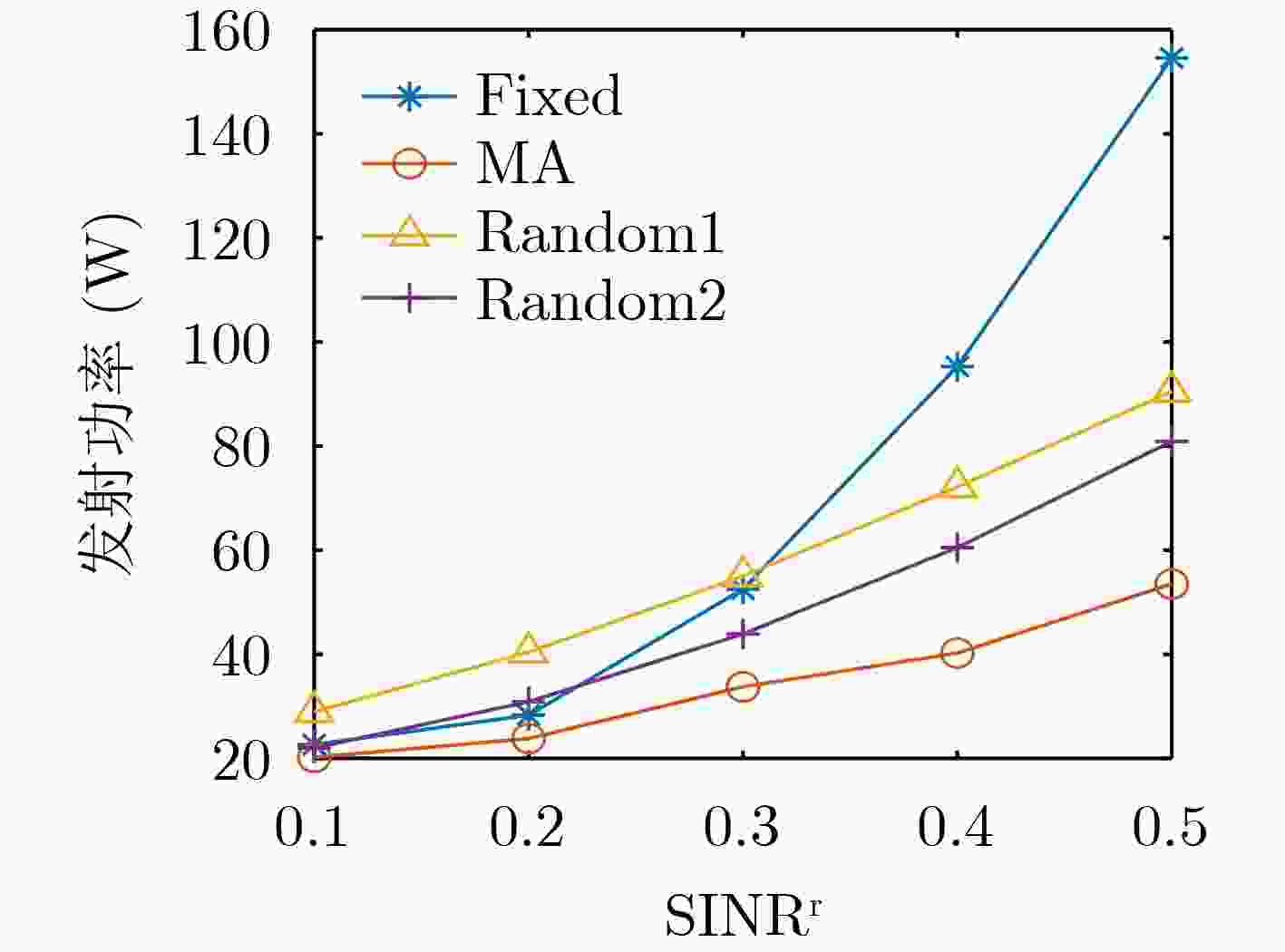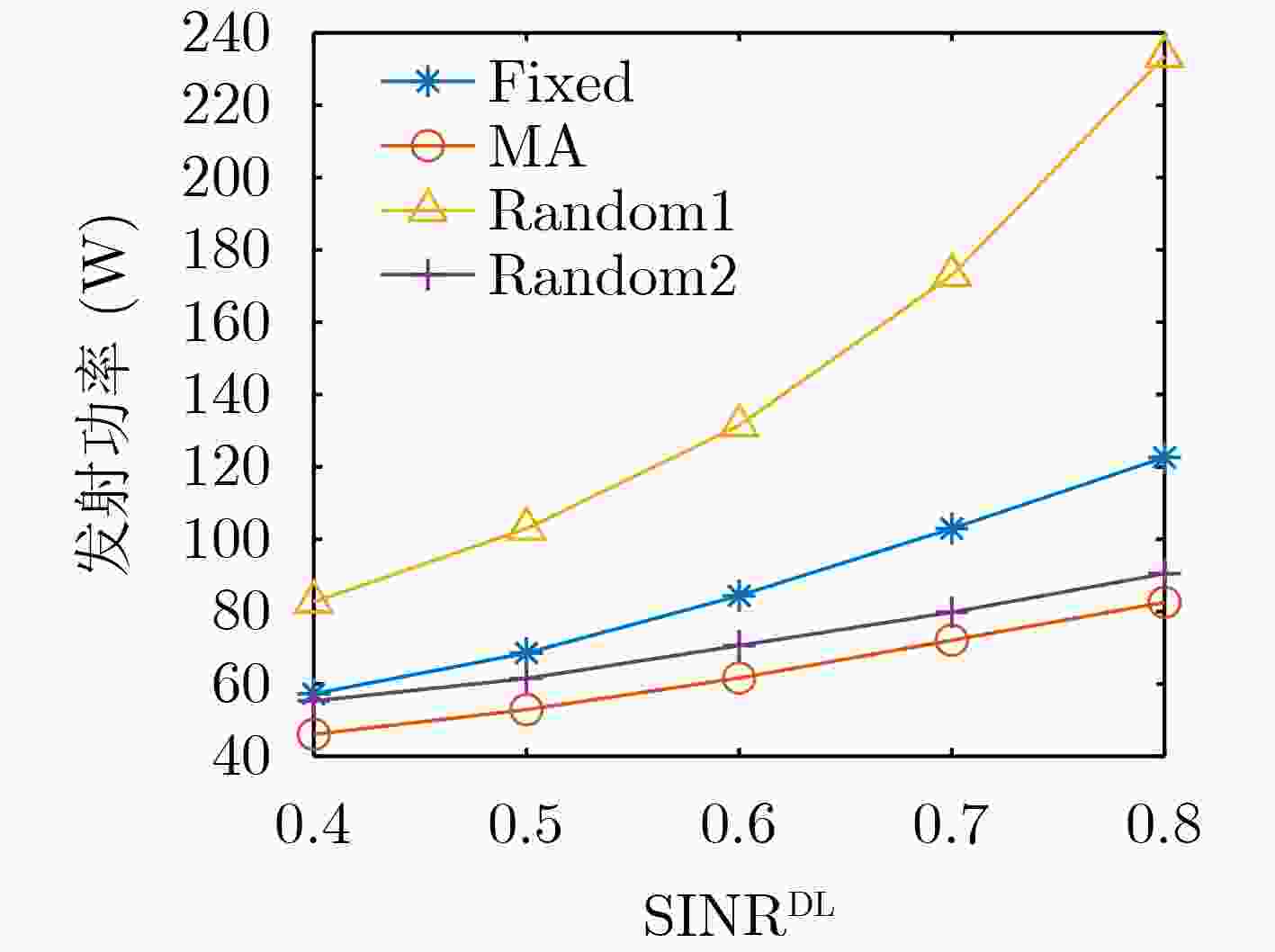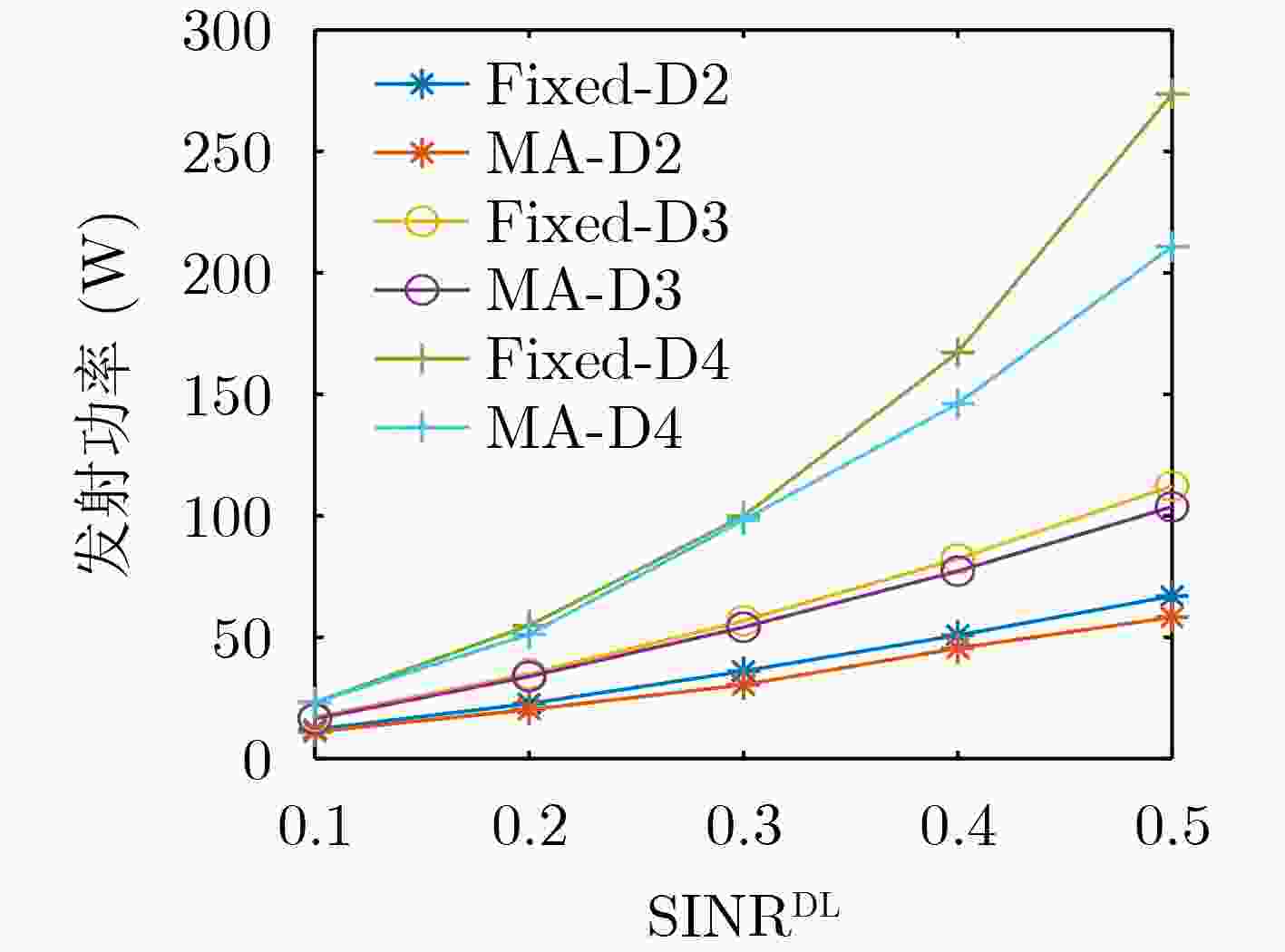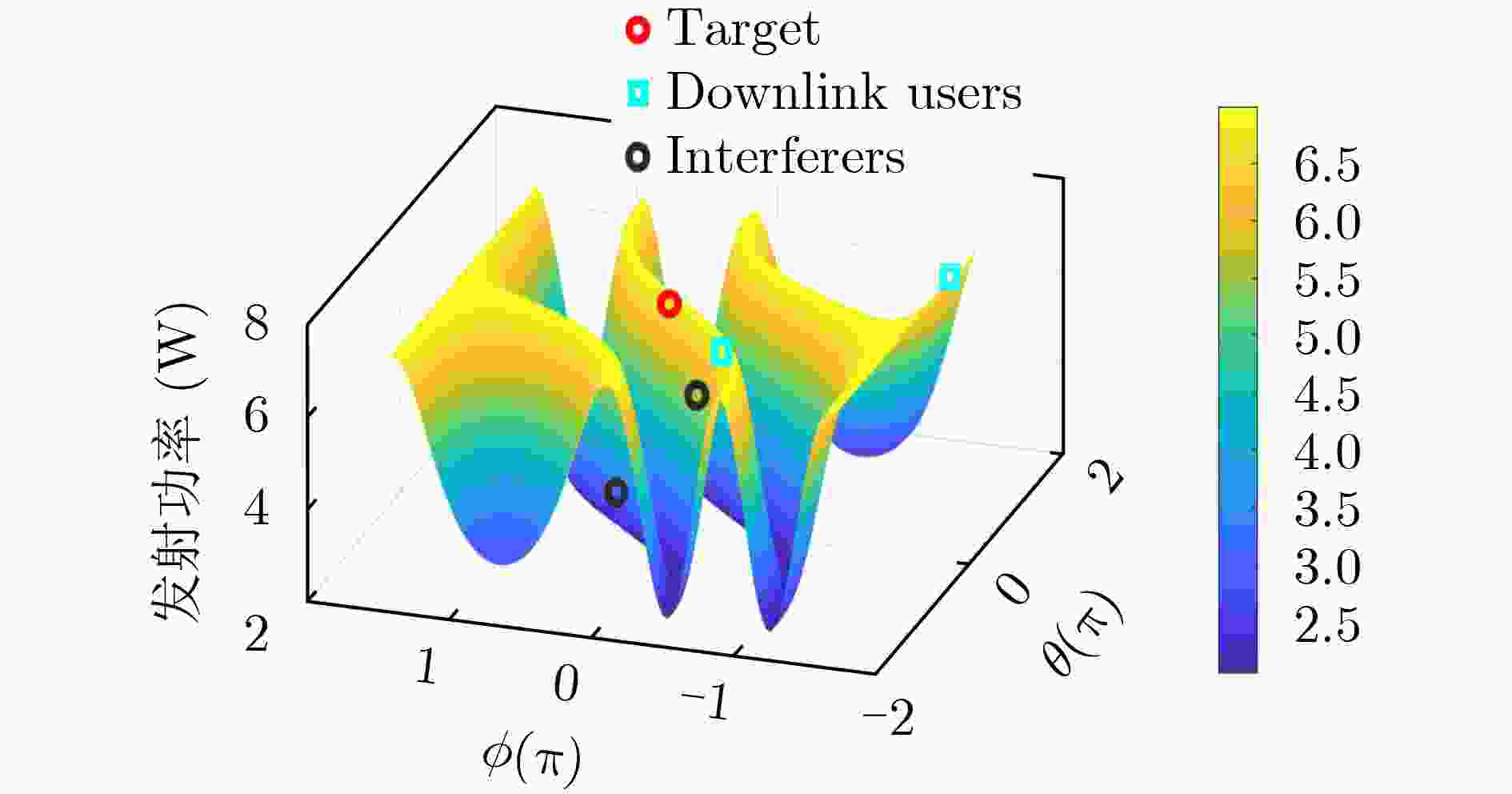Joint Beamforming and Antenna Position Optimization in Movable Antenna Empowered ISAC Systems
-
摘要: 该文聚焦于通信感知一体化(ISAC)系统性能优化问题,提出一种可移动天线(MA)赋能的创新解决方案。针对传统固定天线阵列因空间自由度受限导致的波束调控能力不足,该研究通过动态调整发射端MA元素的位置来充分利用无线信道空间特性。在满足用户通信与雷达感知需求的约束条件下,建立了包含MA元素离散位置、波束赋形向量和感知信号协方差矩阵的联合优化模型,以最小化系统发射功率。为解决优化变量耦合度高且包含二元离散变量的难题,该文采用离散二进制粒子群优化(BPSO)算法框架进行求解。具体地,首先,通过适应度函数迭代地确定MA元素的离散位置,并运用半正定松弛(SDR)和逐次凸近似(SCA)技术处理非凸约束,进一步求解波束赋形向量和感知协方差矩阵。仿真结果表明,相较于传统固定天线阵列基准方案,所提方案在降低ISAC系统发射功率方面具有显著优势。该文为MA赋能的ISAC系统能耗优化提供了新的思路,对下一代无线通信系统的通信感知融合网络设计具有重要指导意义。
-
关键词:
- 通信感知一体化 /
- 可移动天线 /
- 离散二进制粒子群优化 /
- 波束赋形
Abstract:Objective With the rapid advancement of information technology, mobile communication is transitioning from the fifth generation (5G) to the sixth generation (6G), with a central goal of evolving from the Internet of Things to the Internet of Intelligence. Integrated Sensing and Communication (ISAC) has emerged as a key technology for next-generation wireless systems. By jointly designing sensing and communication functionalities, ISAC substantially improves spectral efficiency and overall system performance, and is regarded as a core technology for future intelligent networks. However, conventional fixed antenna arrays are limited by insufficient spatial degrees of freedom, making them inadequate for meeting the stringent sensing and communication requirements in dynamic and complex environments. To address this challenge, Movable Antenna (MA) is proposed as a novel architecture. MA systems enable antenna elements to move within designated transmit and receive regions, allowing real-time adjustment of their positions according to instantaneous channel states and system demands. This study proposes an MA-empowered ISAC framework that dynamically reconfigures antenna positions to exploit the spatial characteristics of wireless channels, with the objective of minimizing transmit power. The proposed design contributes new insights into energy-efficient ISAC system development and offers theoretical and practical relevance for future wireless communication networks. Methods This study formulates a joint optimization problem that considers the discrete positions of MA elements, beamforming vectors, and sensing signal covariance matrices. To address the inherent coupling among optimization variables and the presence of binary discrete variables, a Discrete Binary Particle Swarm Optimization (BPSO) framework is adopted. The algorithm iteratively determines the discrete antenna positions through a fitness-based search. Based on the obtained positions, Semi-Definite Relaxation (SDR) and Successive Convex Approximation (SCA) techniques are applied to manage non-convex constraints and solve for the beamforming vectors and sensing covariance matrices. This approach yields suboptimal yet effective solutions in complex non-convex optimization scenarios, thereby enhancing system performance. In terms of system modeling, a Dual-Function Radar and Communication Base Station (DFRC BS) equipped with MA is considered. The DFRC BS transmits downlink ISAC signals, communicates with multiple single-antenna downlink users, and senses a radar target. Antenna elements are restricted to a discrete set of candidate positions, facilitating practical system deployment. The radar sensing channel is modeled as a Line-of-Sight (LoS) channel, whereas the communication channels follow a field-response-based model. The DFRC BS transmits narrowband ISAC signals through beamforming, which are used concurrently for radar target detection and downlink communication. Results and Discussions Simulation results demonstrate that the proposed MA-empowered ISAC system achieves superior performance in transmission power optimization compared with conventional fixed antenna array systems. Under the constraint of sensing Signal-to-Interference-plus-Noise Ratio (SINR), transmit power increases with more stringent sensing requirements. However, the MA-empowered ISAC system substantially lowers the required transmit power, with a maximum observed reduction of 101.1 W. Under the communication SINR constraint and fixed sensing requirements, transmit power also rises as communication demands grow. In this setting, the MA-empowered ISAC system again shows a clear advantage, reducing transmit power by up to 134.6 W compared with traditional systems. Furthermore, as the number of downlink users increases—while maintaining consistent sensing and communication requirements—transmit power increases accordingly. Even under these conditions, the MA-empowered system continues to outperform its fixed-array counterpart. Beamforming pattern simulations further confirm that the BPSO-based optimization framework achieves multi-beam alignment and provides a degree of interference suppression, highlighting its effectiveness in managing dual-function transmission within MA-enabled ISAC systems. Overall, the introduction of MA significantly enhances ISAC system performance in terms of energy efficiency and spatial adaptability. Conclusions This paper proposes a joint optimization framework based on Discrete BPSO for MA-empowered ISAC systems, which effectively reduces transmit power while maintaining sensing and communication performance. The optimization process begins by iteratively solving a fitness function to determine the discrete positions of the MA elements. SDR and SCA techniques are employed during this process to address non-convex constraints. Once the MA element positions are established, the associated beamforming vectors and sensing signal covariance matrices are computed or further optimized. By dynamically adjusting antenna positions, the system gains additional spatial degrees of freedom, enabling more efficient utilization of the spatial characteristics of wireless channels. This work provides a new approach for energy-efficient design in ISAC systems and offers meaningful guidance for the development of next-generation wireless networks. Future research will continue to explore advanced optimization algorithms for MA positioning and system performance enhancement, aiming to meet sensing and communication requirements in highly dynamic environments. Additionally, the applicability of MA in other wireless scenarios—such as vehicular networks and aerial communication platforms, will be studied to facilitate broader adoption of MA-based technologies. -
1 MA天线定位和波束赋形联合优化算法
(1)初始化:$ {\boldsymbol{r}} $,${\boldsymbol{B}}$,$\left\{ {{{\boldsymbol{w}}_d}} \right\}_{d = 1}^D$,${{\boldsymbol{W}}_0}$; (2)设置最大迭代次数$J$; (3)重复; (4)更新$j = j + 1$; (5)给定$\left\{ {{\boldsymbol{w}}_d^{\left( {j - 1} \right)}} \right\}_{d = 1}^D$和${\boldsymbol{W}}_0^{\left( {j - 1} \right)}$,计算适应度函数的值以获得局部最优的$\tilde {\boldsymbol{b}}_i^*$和当前的全局最优的${\tilde {\boldsymbol{b}}^*}$。然后求解式(11)–式(13),得到
并存储中间解${\boldsymbol{B}}_{}^{(j)}$;(6)给定${\boldsymbol{B}}_{}^{(j)}$,求解问题(P7),并存储中间解$\left\{ {{\boldsymbol{w}}_d^{\left( j \right)}} \right\}_{d = 1}^D$和${\boldsymbol{W}}_0^{\left( j \right)}$; (7)直到收敛或达到最大迭代次数; (8)根据全局最优的${\tilde {\boldsymbol{b}}^*}$,获得对应的解$ {{\boldsymbol{r}}^ * } $, ${{\boldsymbol{B}}^ * }$, $\left\{ {{\boldsymbol{w}}_d^ * } \right\}_{d = 1}^D$, ${\boldsymbol{W}}_0^*$; (9)根据式(17),计算接收波束赋形向量$ {{\boldsymbol{r}}^ * } $。 -
[1] 中国通信学会. 通感算一体化网络前沿报告(2021年)[R]. 2022: 1–74.China Institute of Communications. Frontier Report on Integrated Sensing, Communication, and Computing Networks (2021) [R]. 2022: 1–74. [2] IMT-2030 (6G)推进组. 通信感知一体化技术研究报告[R]. 2021: 1–61.China Institute of Communications (CIC). Frontier Report on Integrated Sensing, Communication, and Computing Network (2021) [R]. 2022: 1–61. [3] MENG Kaitao, MASOUROS C, PETROPULU A P, et al. Cooperative ISAC networks: Performance analysis, scaling laws, and optimization[J]. IEEE Transactions on Wireless Communications, 2025, 24(2): 877–892. doi: 10.1109/TWC.2024.3491356. [4] JIANG Chengjun, ZHANG Chensi, HUANG Chongwen, et al. RIS-assisted ISAC systems for robust secure transmission with imperfect sense estimation[J]. IEEE Transactions on Wireless Communications, 2025, 24(5): 3979–3992. doi: 10.1109/TWC.2025.3534439. [5] MENG Chunwei, WEI Zhiqing, MA Dingyou, et al. Multiobjective-optimization-based transmit beamforming for multitarget and multiuser MIMO-ISAC systems[J]. IEEE Internet of Things Journal, 2024, 11(18): 29260–29274. doi: 10.1109/JIOT.2024.3413687. [6] GAO Zhen, WAN Ziwei, ZHENG Dezhi, et al. Integrated sensing and communication with mmWave massive MIMO: A compressed sampling perspective[J]. IEEE Transactions on Wireless Communications, 2023, 22(3): 1745–1762. doi: 10.1109/TWC.2022.3206614. [7] ZHAO Xin, LIU Heng, GONG Shiqi, et al. Dual-functional MIMO beamforming optimization for RIS-aided integrated sensing and communication[J]. IEEE Transactions on Communications, 2024, 72(9): 5411–5427. doi: 10.1109/TCOMM.2024.3384932. [8] ZHANG Jiexin, XU Shu, ZHANG Zhengming, et al. A denoising diffusion probabilistic model-based digital twinning of ISAC MIMO channel[J]. IEEE Internet of Things Journal, 2025, 12(15): 29121–29134. doi: 10.1109/JIOT.2024.3495212. [9] 李斌, 杨冬东. 同时透射反射可重构智能表面赋能移动边缘计算任务卸载研究[J]. 电子与信息学报, 2025, 47(2): 418–426. doi: 10.11999/JEIT240733.LI Bin and YANG Dongdong. Task offloading for simultaneously transmitting and reflecting reconfigurable intelligent surface-assisted mobile edge computing[J]. Journal of Electronics & Information Technology, 2025, 47(2): 418–426. doi: 10.11999/JEIT240733. [10] HUA Haocheng, HAN Tonyxiao, and XU Jie. MIMO integrated sensing and communication: CRB-rate tradeoff[J]. IEEE Transactions on Wireless Communications, 2024, 23(4): 2839–2854. doi: 10.1109/TWC.2023.3303326. [11] WANG Peng, HAN Dongsheng, CAO Yashuai, et al. Multi-objective optimization-based waveform design for multi-user and multi-target MIMO-ISAC systems[J]. IEEE Transactions on Wireless Communications, 2024, 23(10): 15339–15352. doi: 10.1109/TWC.2024.3428705. [12] SHI Xiaoming, SHAO Xiaodan, and ZHANG Rui. Capacity maximization for base station with hybrid fixed and movable antennas[J]. IEEE Wireless Communications Letters, 2024, 13(10): 2877–2881. doi: 10.1109/LWC.2024.3451481. [13] FENG Biqian, WU Yongpeng, XIA Xianggen, et al. Weighted sum-rate maximization for movable antenna-enhanced wireless networks[J]. IEEE Wireless Communications Letters, 2024, 13(6): 1770–1774. doi: 10.1109/LWC.2024.3390428. [14] WEI Xin, MEI Weidong, WANG Dong, et al. Joint beamforming and antenna position optimization for movable antenna-assisted spectrum sharing[J]. IEEE Wireless Communications Letters, 2024, 13(9): 2502–2506. doi: 10.1109/LWC.2024.3421636. [15] GAO Ying, WU Qingqing, and CHEN Wen. Joint transmitter and receiver design for movable antenna enhanced multicast communications[J]. IEEE Transactions on Wireless Communications, 2024, 23(12): 18186–18200. doi: 10.1109/TWC.2024.3463390. [16] ZHU Lipeng, MA Wenyan, and ZHANG Rui. Movable antennas for wireless communication: Opportunities and challenges[J]. IEEE Communications Magazine, 2024, 62(6): 114–120. doi: 10.1109/MCOM.001.2300212. [17] WANG Chao, LI Zan, WONG K K, et al. AI-empowered fluid antenna systems: Opportunities, challenges, and future directions[J]. IEEE Wireless Communications, 2024, 31(5): 34–41. doi: 10.1109/MWC.017.2300527. [18] XIU Yue, YANG Songjie, LYU Wanting, et al. Movable antenna enabled ISAC beamforming design for low-altitude airborne vehicles[J]. IEEE Wireless Communications Letters, 2025, 14(5): 1311–1315. doi: 10.1109/LWC.2025.3538587. [19] QIN Haoran, CHEN Wen, WU Qingqing, et al. Cramér-Rao bound minimization for movable antenna-assisted multiuser integrated sensing and communications[J]. IEEE Wireless Communications Letters, 2024, 13(12): 3404–3408. doi: 10.1109/LWC.2024.3468709. [20] DING Jingze, ZHOU Zijian, LI Wenyao, et al. Movable antenna-enabled co-frequency co-time full-duplex wireless communication[J]. IEEE Communications Letters, 2024, 28(10): 2412–2416. doi: 10.1109/LCOMM.2024.3453296. [21] CHEN Li, WANG Zhiqin, DU Ying, et al. Generalized transceiver beamforming for DFRC with MIMO radar and MU-MIMO communication[J]. IEEE Journal on Selected Areas in Communications, 2022, 40(6): 1795–1808. doi: 10.1109/JSAC.2022.3155515. [22] TSINOS C G, ARORA A, CHATZINOTAS S, et al. Joint transmit waveform and receive filter design for dual-function radar-communication systems[J]. IEEE Journal of Selected Topics in Signal Processing, 2021, 15(6): 1378–1392. doi: 10.1109/JSTSP.2021.3112295. [23] ZHANG Ruoyu, CHENG Lei, ZHANG Wei, et al. Channel estimation for movable-antenna MIMO systems via tensor decomposition[J]. IEEE Wireless Communications Letters, 2024, 13(11): 3089–3093. doi: 10.1109/LWC.2024.3450592. [24] SHEKHAR S, SUBHASH A, SRINIVASAN M, et al. Joint power-control and antenna selection in user-centric cell-free systems with mixed resolution ADC[J]. IEEE Transactions on Communications, 2022, 70(12): 8400–8415. doi: 10.1109/TCOMM.2022.3218835. -






 下载:
下载:






 下载:
下载:
